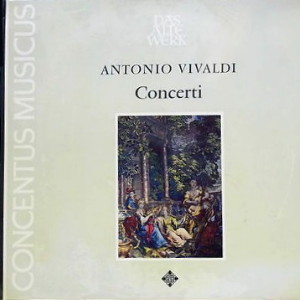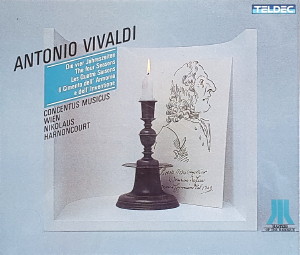 |
1 LP -
6.41961 AW - (p) 1976
|
 |
| 3 CD -
8.35777 XD - (c) 1989 |
|
| Antonio Vivaldi
(1678-1741) |
|
|
|
|
|
|
|
| Concerti |
|
|
|
|
|
|
|
Concerto a-moll für Oboe,
Streicher und B.c. (Violoncello,
Violone, Cembalo) (F. VII/13) (P. 89)
|
|
9' 27" |
A1 |
- Allegro
|
3' 25" |
|
|
| - Largo |
3' 07" |
|
|
| - Allegro |
2' 55" |
|
|
Concerto g-moll für
Querflöte, Oboe, Violine, Fagott und
B.c. (Violoncello, Cembalo) (F. XII/6)
(P. 360)
|
|
8' 59" |
A2 |
| - Allegro |
2' 12" |
|
|
- Largo
|
3' 56" |
|
|
- Allegro
|
2' 51" |
|
|
Concerto e-moll für Fagott,
Streicher und B.c. (Violoncello,
Violone, Cembalo) (F. VIII/6) (P. 137)
|
|
10' 40" |
B1 |
- Allegro poco
|
4' 25"
|
|
|
| - Andante |
3' 03" |
|
|
| - Allegro |
3' 12" |
|
|
Concerto für Streicher
g-moll (F. XI/21) (P. 361)
|
|
5' 30" |
B2 |
- Allegro
|
1' 53"
|
|
|
| - Largo |
1' 32" |
|
|
- Allegro
|
2' 05" |
|
|
|
|
|
|
CONCENTUS MUSICUS
WIEN (mit Originalinstrumenten)
|
|
| -
Jürg Schaeftlein, Oboe |
-
Wilhelm Mergl, Violine |
|
| -
Leopold Stastny, Querflöte |
-
Josef de Sordi, Violine |
|
| -
Milan Turkovic, Fagott |
-
Kurt Theiner, Viola |
|
| -
Alice Harnoncourt, Violine |
-
Nikolaus Harnoncourt, Violoncello |
|
| -
Walter Pfeiffer, Violine |
-
Eduard Hruza, Violone |
|
| -
Peter Schoberwalter, Violine |
-
Herbert Tachezi, Cembalo |
|
|
|
| Nikolaus Harnoncourt, Leitung |
|
|
Luogo
e data di registrazione
|
| Casino Zögernitz,
Vienna (Austria) - 1973 |
|
Registrazione
live / studio
|
| studio |
Producer
/ Engineer
|
-
|
Prima Edizione CD
|
Teldec
"Masters of the Baroque" - 8.35777 XD -
(3 cd) - 70' 12" + 71' 37" + 64' 22" -
(c) 1989 - ADD
|
|
Prima
Edizione LP
|
Telefunken "Das
Alte Werk" - 6.41961 AW
- (1 lp) - 34'
53"
- (p) 1976
|
|
|
Notes
|
The
works in our recording show
very clearly the qualities
on which Vivaldi's fame was
based. These are the strcit
and strikingly simple
framework of the three-part
concerto form, the
standardisation of which he
pursued more decisively than
most of his contemporaries;
the formation of individual
movements in regular
alternation between
thematically forceful tutti
and worthwhile, often
virtuoso, solos; a wealth of
inspiration as regards theme
and style which was able to
expand all the more
effectively the more
strictly the grosso forms
were standardized, tonal
imagination coupled with
virtuosity and colourfulness
of orchestral and solo
arrangement directly linked
with Vivaldi's orchestra
practice at the Ospedale
della Pietà. Many of his
contemporaries, Bach in
particular, were superior to
the fast and prolific
Vivaldi as regards accuracy
of workmanship and depth of
expression. Many of the
younger ones, especially
Sammartini, who quickly
pushed him into obscurity,
decisively rejected the
traditions of the 17th
century. But hardly one of
them was equal to him when
it was a matter of abundance
od ideas and that brilliant
joy in making music and
musical sensuousness which
have kept Vivaldi's music
young until our own times.
The Oboe Concerto in A minor
(also passed on as the
Bassoon Concerto) displays
the "classical" form of the
Vivaldi concerto. Two
energetic allegro movements,
in marked virtuoso style for
the oboe form the framework
for an intimate largo which
draws its life entirely from
the blissful cantilene of
the solo instrument. The
outer movements are exactly
the same in form, complete
multi-tiered tutti at the
beginning and end, and in
between three free solos,
interrupted by two
abbreviated tuttis.
But in detail they very
subtly contrast with each
other. For instance, in the
first movement during the
solos elements of the tutti
themes are used in the
orchestra as accompaniment.
In the finale on the other
hand, which surprisingly
begins with a four-part
fugue exposition, the
orchestra provides for each
solo a new, non-thematic
accompanying movement. The
only non-typical aspect of
the entire concerto is that
the finale is in C major
instead of A minor.
The Concerto for Transverse
Flute, Oboe, Violin, Bassoon
and Thoroughbass in G minor
is, despite its title, less
a concerto than a sonata a
quattro, admittedly with
concerto-like themes and
concerto-virtuoso solos,
particularly in the first
movement. However, this
movement also reveals
chamber musical delicacy in
the comparatively
wide-ranging modulation
plan, in the multiplicity of
solo-tutti alternation, and
in the ingenious play with
constantly changing
instrumental combinations.
The largo - strangely enough
in the basic key of G minor
- is one of Vivaldi's
loveliest Siciliano
movements: closely related
to folk music in the
touchingly simple melody of
flute and oboe, and at the
same time quite subtle in
the accompanying subject of
violin and bassoon, and in
the harmony (G minor / A
major, B-flat major / G
major). The finale is a
passacaglia (with some
liberties taken) on an
eicht-bur bass which
intensifies with ever new
virtuoso and concertante
concepts into a fast-moving
conclusion.
The Bassoon Concerto in E
minor enriches the
"classical" type of Vivaldi
concerto by close motif
links between tutti and
solos, continuous motif
accompanying subjects to
individual solos and motif
contrasts in the tutti.
Vivaldi was the first to use
the bassoon as a solo
instrument, and no less than
39 bassoon concertos by him
have come down to us. This
piece is most probably a
late work; the first
movement in particular, with
its slow tempo, its
song-like main motif and
richly contrasting tutti
exposition, decisively
points ahead to the
"sensitive" style. The solo
instrument also inclines
more to blissfully cantabile
than virtuoso performance
treatment. In the slow
movement this cadence, in
conjunetien with the key (B
minor), brooding unisoni and
sighing melodies, works
itself up into almost scenic
clarification. Even the
finale, because of its
concentration on the
secondary motif of the
beginning and the strangely
disrupted cantilenas of the
bassoon, have a touch of
wildness which is highly
unusual for Vivaldi's
concluding movements. The
exploitation of the bassoon
for dark, melancholy and
violent ological
achievements of the
composer: the "discovery" of
emotions provides one of the
decisive musical and music
not only the technical
performance but also the
emotional possibilities of
instruments which hitherto
had been condemned to act as
thoroughbass instruments.
While the Bassoon Concerto
is probably a late work, the
Concerto for Strings and
Thoroughbass in G minor is
presumably a very early
composition, according to
the instrumentation (with
largely dependent cellos and
basses) a sinfonia a
quattro. Judging by movement
type and technique it is a
work of the immediate
post-Corelli period. The
first movement is a
passacaglia above a
twenty-fold reappearing
chromatic bass; the upper
voices, basically only the
two violins, arrange ten
consecutives sections, each
independent from a motif
point of view, which are
worked in doubled
counterpoint and are
developed from the typical
contrapuntal and concertante
turns of the Corelli style.
The solemn B-flat major
largo also, entirely
developed from a pointed
scale motif, still owes
something to this style
pattern, even though the
colourful change from D
minor to D major (10 bars
before the conclusion)
provides a more modern
accent. Only the finale is
at least in cadence, marked
by the spirited runs of the
basses, a "genuine" concerto
movement, in which all the
stops of performance
virtuosity are pulled.
As regard form, on the other
hand, it is inferior to
Vivaldi's more developed
concerto movement form
because of the rapid
sequence of cadences, mainly
in regular intervals of four
bars, the change from
sections in parallels of the
third, in the double
counterpoint in the two
violins, and because of the
singular form arrangement,
which is between concerto
movement and rondo (A B A C
A B' A A B"). In its
turbulent, reckless
activity, the movement seems
- after the dignified
contrapuntal journeyman's
pieces of the preceding
movements - to refleet
something like a mood of
fundamental change. The
effects of this change are
shown in the other works of
our recording.
----------
Vivaldi's
concerto works, wich have
not been fully explored even
to the present time, were
recognized at a late stage
as regards their
musicological significance,
and rediscovered even later
from the point of view of
performance. On the other
hand Vivaldi's
contemporaries regarded this
"prete rosso", the
readhaired priest who
trained the Orchestra of the
Ospedale della Pietà in
Venice to an unheard of high
standard and had also become
famous as a leading concerto
violinist, as the most
outstanding concerto
composer of the epoch. At
least between 1710 and 1730,
when Vivaldi's fame took on
European proportions and
increasing numbers of his
concertos were distribuited
in printed form (admittedly
only a fifth of some 450
that have been handed down),
there was scarcely a music
region where Vivaldi
concertos were not played
discussed and imitated. Even
prior to 1710, works found
their way to Germany, a
little later to Paris and
London. In 1712 Roger began
to print Vivaldi works in
Amsterdam, the centre of
music publishing at that
time. Five years later the
violinist Pisendel, who had
studied under the prete
rosso in Venice, made
Dresden the focal point of
cultivation of Vivaldi,
which made a lasting
impression on Bach. Even the
Czech emigrants, who as
Mannheimers helped to
prepare the path to the
classics, learned from the
Vivaldi concertos they had
got to know in Prague and in
the castles of the Bohemian
aristocracy. The fact that
towards the end of his life
Vivaldi was vehemently
criticized north of the Alps
of all places and that after
his death he was quickly
forgotten cannot alter the
other fact that up to the
threshold of the decisive
change in style between 1730
and 1750, he played the
first violin in the
"European concert."
English
translations by
Frederick A. Bishop
|
|
Nikolaus
Harnoncourt (1929-2016)
|

|

|
|